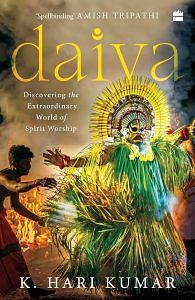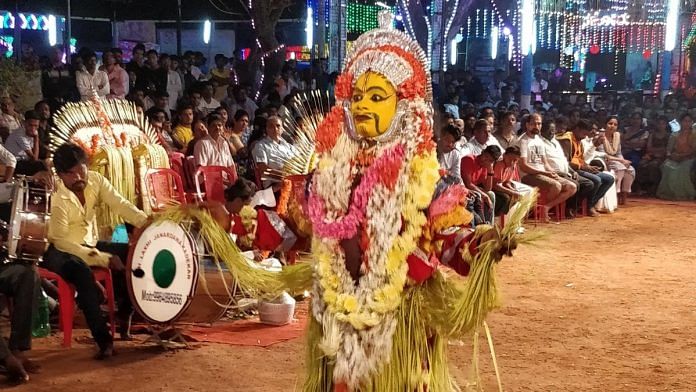Last year I visited the city where I spent my childhood, Gurgaon, to attend a literary event hosted by my alma mater. As was customary, I made it a point to catch up with old friends whenever I visited the city. Thus, on a balmy winter afternoon, I found myself ensconced in a quaint café in the bustling Galleria market, my senses lulled by the heady aroma of Irish coffee (trust me, this was an exception. The only coffee I love and drink is the filter kaapi). It was then that my school friend, Deva, while waiting for his cup of cappuccino, after talking about a lot of nostalgic things, brought up the topic of Kantara. Gushing over the film’s brilliance, he extolled the virtues of the South Indian film industry over Bollywood.
I lamented the monolithic label of ‘South Indian’ that did little justice to the rich diversity that pervaded the four distinct film industries of the South (It is actually six, if you include the lesser known Tulu industry of South Canara and Dollywood or the Deccani film industry of Hyderabad). Thus began a conversation that would soon transport us to the mystical realm of kola and daiva aaradhane, and it was then that my friend posed a question that was both surprising and heartwarming, ‘You are a Tuluva, right?’ I nodded. ‘Do people from your region really worship ghosts?’ he asked. I took a deep breath and let out a sigh. This was a question that many people have asked, including on some interviews and podcasts.
In the lexicon of the Tuluva people, ‘bhuta’ is not a word that is casually tossed around as a synonym for ghosts or evil spirits. In fact, the Tuluva people would argue that such an association with their traditional practices is deeply flawed and entirely misplaced. It is true that the word ‘bhoot’ (in most Indian languages) is commonly used to refer to ghosts or something that once existed but is now no more.
Also read: A new language war in Karnataka is brewing. This time over Tulu dignity
Typical logic leads to the term ‘dead’ and anything dead can come back to haunt as a ‘ghost’. Because people are scared of ghosts, they demarcate them as ‘evil’. Due to this association, it’s not difficult to see why bhuta-kola is often perceived by outsiders as the dance of the malevolent ghost, devil or demon. However, such a definition falls far short of capturing the rich and complex cultural significance of ‘bhuta’ as it is understood by the Tuluva people. ‘Bhuta’ represents something altogether more profound, something that cannot be so easily dismissed or explained away as mere superstition or myth.
So, after a brief delay, I told my friend, ‘Bhutas are not ghosts, dear. You can consider them as spirits of long-gone local legends and heroes that are worshipped to this day.’
‘So, there is no supernatural force involved?’ he asked out of curiosity. I was pretty sure that he was recollecting the climax of that Kannada film which triggered this conversation. With a warm smile, I explained, ‘Well, it is believed that there is a supernatural force but it is not evil or malevolent. Rather, it is considered divine in nature. This force enters the kola dancer.’ ‘Like in the film …’ Smile still in place, I said, ‘Almost.’
In Sanskrit, the word Bhuta could mean ‘the past’, ‘the spirit of the dead’, ‘the elements’ or ‘Shiva’s attendants’, while aaradhana denotes devotion or worship. So, bhuta-aaradhane may literally mean worship of these spirits.
It was at that moment that the attendant arrived with a steaming cappuccino for my companion and placed it on the desk. My friend reached for a sachet of sugar and, whilst adding it to the coffee, opined, ‘Hari, I stumbled upon some stuff on the internet, alright? Some claimed that bhuta kola was a form of devil worship.’ ‘Indeed, I am afraid that is true.’ ‘So, these aren’t ghosts, but rather devils?’ ‘No. I mean, it is true that some people had claimed it was devil worship, but actually, it is not like that.’
‘I fail to understand. Why then did they call it the cult of devil worship?’ he queried, his thick digits gripping the wooden stirrer. ‘It is a result of religious misinterpretation and appropriation. What you read was likely influenced by the perspectives of colonial authors for whom the kola rituals seemed feral and satanic. It is possible that they based their initial impressions based on the views of their informants.
They equated bhuta with Satan or, in broader terms, the devil.’ ‘Ah, that elucidates the matter. So, bhuta is not an impish spirit or the devil.’ ‘Correct, but they are feared by the worshippers too.’ ‘Why so?’ he inquired, returning the stirrer to its tray. ‘Because if provoked, sometimes these spirits may inflict harm.’ In that moment, the elbow of my cherished companion, by chance, made contact with the handle of the ceramic vessel that held the frothy cappuccino, causing it to plummet to the ground, breaking into countless fragments. A scant few droplets of the scalding brew, in a close shave, spattered onto the expanse of his beige polo shirt, barely skirting his bare brown arms. Subsequent to this incident, his words on the subject were muted. Possibly, he harboured fear.
Fear has forever been a tool employed by the aged to discipline the young. That is why most grandmothers regale kids with tales of ghosts and witches that would abduct disobedient kids who neglected to heed their parents or skipped bathing. I recollect that when I was six or seven-years-old, my ajja (grandfather) once caught me biting into a chakkuli (chakli or murukku, whatever you’d like to call it in your region). Basically, we call this way of eating ‘made ampuna’ in Tulu or ‘jootha karke khaana’ in Hindi. Ajja ensnared my left ear in his grasp and admonished me that children who bit into chakkuli or any snack would be abducted by a yakshi. He counselled me to rend them into fragments with the right hand and ingest them one at a time, like ‘civilized’ individuals.
Even to this very day, I vow, I do not directly bite into any snack. Rather, I dismember them into smaller portions and deposit them, piece by piece, into my mouth. Of course, this tendency promotes hygiene especially while sharing food, but truth remains that the fear factor worked effectively in disciplining the child. Religion uses fear too. The Basel Missionaries are credited with disseminating modern techniques of tile manufacturing, weaving, and for bringing the first printing press to the shores of coastal Karnataka in 1841, (Hindu, 2016). However, upon their arrival in coastal Karnataka two centuries ago, their dealings with the bhutas of Tulu Nadu were not harmonious, for they considered them to be devilish, the enemies of God, and proponents of evil.
They appeared as pagan modes of worshiping nature or something far more sinister. According to their religious views, serving the bhutas was a sure way to eternal damnation. Their condescension and lack of appreciation of the bhutas’ place in local culture is apparent as the people have been referred to as heathens in their annual reports (the forty-sixth report of the Basel German Evangelical missionary society in South-Western India for 1885, 1886).
The colonial writers of the time also found the music of the kola rituals too loud and disharmonious, and the physicality of the performance too violent. They deemed it an offense to the sensibility and equated the idea of the numerous bhutas with that of the devil and demons. Come to think of it, it wasn’t their fault. The missionaries may have feared burning in hell if they indulged in worshipping anyone except the one true God (mentioned in their scriptures), just like the natives feared the wrath of their many deities. The fear and belief are purely subjective. Thus, if you pick up any old book or articles about bhuta-aaradhane, you are likely to encounter the terms ‘devil’ or ‘cult.’ But now you know, just like my school friend, that bhutas are not evil ghosts or demons but spirit deities who are worshipped by the natives.
 This excerpt from K Hari Kumar’s ‘Daiva: Discovering the Extraordinary World of Spirit Worship’ has been published with permission from publisher Harper Collins India.
This excerpt from K Hari Kumar’s ‘Daiva: Discovering the Extraordinary World of Spirit Worship’ has been published with permission from publisher Harper Collins India.






